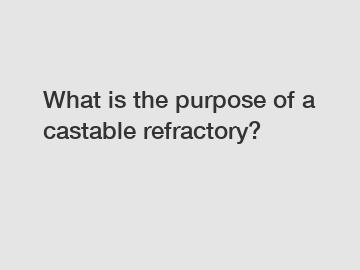What is the purpose of a castable refractory?
What is the purpose of a castable refractory?
A castable refractory serves the essential purpose of providing heat resistance and insulation in various industrial applications. It is a versatile material that is designed to be mixed with water and cast into shapes according to specific requirements. Castable refractories are used in a wide range of industries, including steel, cement, glass, and non-ferrous metals, to protect and line equipment such as furnaces, kilns, and boilers.
The purpose of a castable refractory can be better understood by exploring its origins and the process of how it functions. These refractories are typically composed of aggregates, binders, and additives, which are carefully selected and combined to achieve optimum thermal properties. Aggregates are heat-resistant materials such as alumina, silica, and magnesite, which provide excellent insulation and stability. Binders, such as calcium aluminate cement, hold the aggregates together and ensure a strong, well-bonded structure. Additives are included to enhance the material's workability, strength, and resistance to thermal shock.

The role of a castable refractory becomes significant when considering its impact on industrial processes. The ability to withstand high temperatures, thermal cycling, and corrosive environments makes it an indispensable material for maintaining the integrity and efficiency of equipment. For instance, in steel production, a castable refractory lining in a furnace can protect it from extreme temperatures and chemical reactions, ensuring consistent and high-quality output. Similarly, in the cement industry, castables are used to line rotary kilns and prevent the loss of valuable heat, leading to improved energy efficiency.
The versatility of castable refractories allows for customization according to different industrial requirements. They can be formulated to have varying densities, strengths, and thermal conductivities, enabling precise control over heat transfer. This adaptability is crucial in applications where thermal insulation is crucial, such as in glass manufacturing. Castable refractories with low thermal conductivity minimize heat loss from the furnace and reduce energy consumption, thus resulting in cost savings and environmental benefits.
In conclusion, the purpose of a castable refractory is to provide heat resistance and insulation in various industrial settings. Through a thoughtful combination of aggregates, binders, and additives, castable refractories offer exceptional thermal properties and stability. Their applications span across industries, contributing to the longevity, efficiency, and cost-effectiveness of equipment. As technology advances and the demand for high-performance materials increases, the development and utilization of castable refractories will continue to play a vital role in enhancing industrial processes.
Contact us to discuss your requirements of refractory mortar, industrial furnaces refractory bricks, Fireclay Brick Recipe. Our experienced sales team can help you identify the options that best suit your needs.


